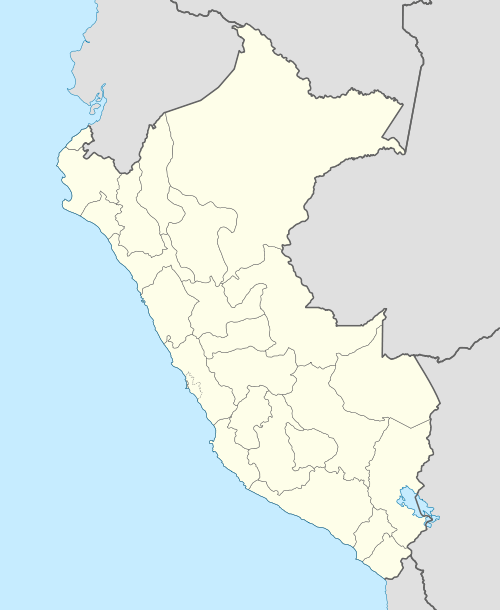Quinsachata (Canchis)
| Quinsachata | |
|---|---|
 Quinsachata Peru | |
| Highest point | |
| Elevation | 3,923 m (12,871 ft) [1] |
| Coordinates | 14.2°0′S 71.33°0′W / 14.200°S 71.330°WCoordinates: 14.2°0′S 71.33°0′W / 14.200°S 71.330°W [1] |
| Geography | |
| Location | Cusco Region |
| Parent range | Andes |
| Geology | |
| Age of rock | 4450 BCE |
| Mountain type | Volcano |
Quinsachata, Kimsachata or Kimsa Chata (Aymara and Quechua kimsa three,[2] Pukina chata mountain,[3] "three mountains", hispanicized spelling Quinsachata) is a volcano in the Andes of Peru. It is located in the Cusco Region, Canchis Province. Sicuani lies about 24 kilometres (15 mi) southeast of Quinsachata.[4] This volcano is constructed from two separate centres, one active 11,500 years ago which formed a scoria cone and a lava field and another active 4450 BCE which formed two lava flows and a lava dome.
Geological context
Volcanism in southern Peru occurs as part of two distinct volcanic systems, the stratovolcanoes of the Western Cordillera and the Altiplano volcanoes which are typically small systems with surface areas of less than 50 square kilometres (19 sq mi). Of these Altiplano volcanoes, a number of them are potassium enriched or ultrapotassic rocks and are arranged along various lineaments. One of these lineaments is associated with the Cusco and Vilcanota faults which separate the Altiplano into a western and eastern portion. Quinsachata is located along this central and still active lineament, whereas the other two lineaments on each side of the fault system were active in the Oligocene and Miocene. A variety of rock types occur in association with these lineaments.[4]
Geology
The Quinsachata group is consists of two volcanoes, Quinsachata itself and Oroscocha. Situated along the foot of the Eastern Cordillera, they are the northernmost young Peruvian volcanoes and lie far away from the principal volcanic arc.[1]
Quinsachata was formed by a scoria cone and a lava field, next to the Vilcanota valley. It erupted about 11,500 years ago.[1] Oroscocha (14°05′48″S 71°22′00″E / 14.09667°S 71.36667°E) is a dome with two associated lava flows that reach thicknesses of 20 metres (66 ft). The volcano covers a surface area of 1.5 square kilometres (0.58 sq mi).[4] Oroscocha was erupted from a fissure about 4450 BCE, and the flow modified the course of the Vilcanota river.[1]
Oroscocha is formed by phenocryst-rich, felsic porphyritic rocks with a composition of peraluminous rhyolite in the flows and trachydacite in the dome, of which the dome is darker than the lava flows. Mafic inclusions with sizes larger in the lava flows than in the dome are also found. The magma that gave rise to the rocks was probably modified by the injection of lamprophyres while still in the magma chamber.[4] Quinsachata is formed by K-rich andesite.[1]
References
- 1 2 3 4 5 6 "Quimsachata". Global Volcanism Program. Smithsonian Institution.
- ↑ www.katari.org Aymara-Spanish dictionary: Kimsa (adj.) – Número Tres.
- ↑ Teofilo Laime Ajacopa, Lengua Pukina en Jesús de Machaca, referring to Alfredo Torero ("Reflexión acerca del pukina escrito por Alfredo Torero ... Pukina <Chata> – Castellano Cerro – Palabras relacionadas en aymara Qullu") (English: mountain). ... Existencia de palabras pukinas en Jesús de Machaca: Qullunaka (cerros): Kimsa Chata
- 1 2 3 4 Carlier, Gabriel; Lorand, Jean-Pierre (August 2008). "Zr-rich accessory minerals (titanite, perrierite, zirconolite, baddeleyite) record strong oxidation associated with magma mixing in the south Peruvian potassic province". Lithos. 104 (1–4): 54–70. doi:10.1016/j.lithos.2007.11.008.